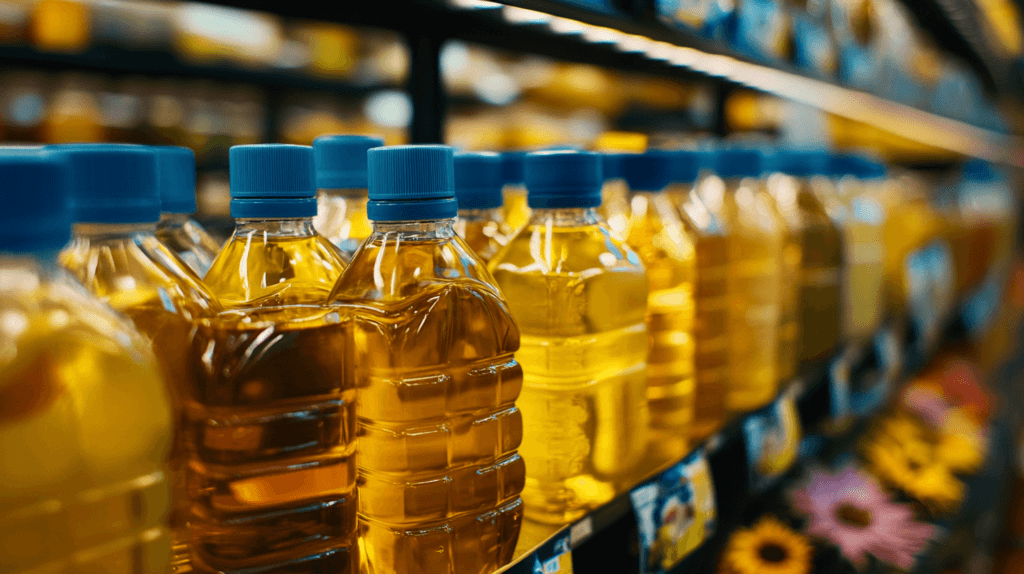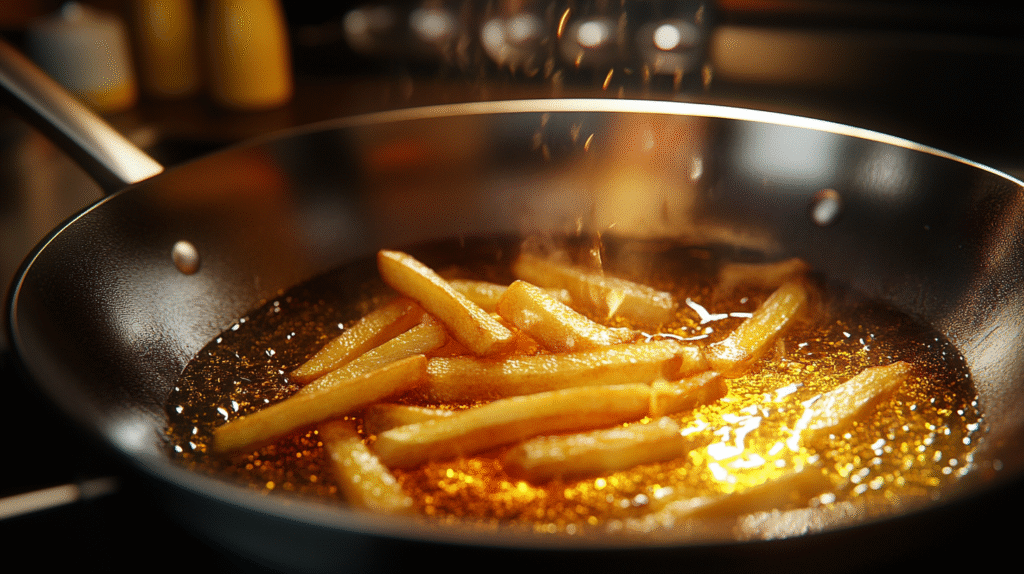Is corn oil good for frying? This question often arises when choosing the perfect oil for crispy, golden-brown dishes. Frying is one of the most popular cooking methods worldwide, producing irresistible textures and flavors. But not all oils perform equally well. Corn oil, known for its high smoke point and neutral flavor, is a popular contender. But does it really meet all the requirements of an ideal frying oil?
In this guide, we’ll dive deep into the properties of corn oil, its advantages and disadvantages in frying, and how it compares to other oils. By the end, you’ll have a clear understanding of whether corn oil deserves a spot in your kitchen for frying needs.
Table of Contents
Understanding Corn Oil
What is Corn Oil?
Corn oil is a type of vegetable oil extracted from the germ of corn kernels. It is known for its light texture, mild flavor, and versatility in cooking. Corn oil is commonly used in frying, baking, and as a base for salad dressings and margarine.
How Corn Oil is Made
The process of making corn oil begins with cleaning and steeping corn kernels. The germ is then separated, and oil is extracted through mechanical pressing or solvent extraction. Finally, the oil undergoes refining to remove impurities and ensure a neutral flavor suitable for cooking.
Nutritional Profile of Corn Oil
Corn oil is rich in polyunsaturated fats (mainly omega-6 fatty acids) and vitamin E, an antioxidant. It contains:
- Fat Composition: 25-30% monounsaturated fats, 50-60% polyunsaturated fats, and 10-15% saturated fats.
- Calories: 120 calories per tablespoon.
- Vitamin E: Offers skin and heart health benefits.
While it’s a calorie-dense oil, corn oil’s composition and antioxidants make it a decent choice for many cooking applications.
The Science of Frying
What Happens During Frying?
Frying involves cooking food in hot oil, typically at temperatures between 325°F and 400°F. When food is submerged, the oil transfers heat, cooking the food rapidly while forming a crispy outer layer. The quality of the oil used greatly impacts the texture, flavor, and nutritional value of the fried food.
Key Qualities of an Ideal Frying Oil
The best frying oils share several characteristics:
- High Smoke Point: To withstand high temperatures without breaking down.
- Neutral Flavor: So it doesn’t overpower the natural taste of food.
- Stability: To resist oxidation and degradation during cooking.
Corn oil checks many of these boxes, making it a popular option for frying.
Common Oils Used for Frying
Aside from corn oil, other commonly used oils include:
- Canola Oil: Known for its mild flavor and low cost.
- Sunflower Oil: High in vitamin E and good for high-heat cooking.
- Olive Oil: Often used for shallow frying due to its distinct flavor.
- Peanut Oil: Favored for its nutty taste and heat stability.
Advantages of Using Corn Oil for Frying

High Smoke Point
One of the most important factors to consider when frying is the oil’s smoke point—the temperature at which it starts to break down and release harmful compounds. Corn oil has a high smoke point of approximately 450°F (232°C), making it well-suited for deep frying, shallow frying, and sautéing without burning or producing unwanted flavors.
Neutral Flavor
Corn oil’s mild, neutral flavor ensures it doesn’t overpower the taste of the food being fried. Whether you’re making crispy fries, golden chicken, or tempura, corn oil allows the natural flavors of the ingredients to shine through.
Health Benefits of Corn Oil
Corn oil contains significant levels of polyunsaturated fats, which can help lower bad cholesterol (LDL) levels when consumed in moderation. Additionally, the vitamin E content in corn oil provides antioxidant benefits, protecting cells from oxidative damage. While frying can add calories to your meals, choosing a heart-friendly oil like corn oil may mitigate some of the health risks associated with fried food.
Potential Drawbacks of Frying with Corn Oil
Oxidation Risk
While corn oil’s high smoke point is a plus, its high concentration of polyunsaturated fats makes it more prone to oxidation when exposed to prolonged heat. Oxidized oils can form harmful compounds, which are associated with inflammation and other health concerns. This makes it essential to use fresh oil and avoid overheating or overusing it.
Fatty Acid Composition Concerns
Corn oil is rich in omega-6 fatty acids, which, while beneficial in moderation, can contribute to an imbalance between omega-6 and omega-3 fats in the diet. This imbalance may lead to inflammation over time, especially when fried foods are consumed excessively.
Comparisons with Other Oils
Compared to oils like canola and sunflower oil, corn oil has similar frying properties but a slightly higher polyunsaturated fat content, which may increase its susceptibility to degradation. On the other hand, it lacks the robust flavor and antioxidant benefits of extra virgin olive oil, making it less ideal for health-focused cooking.
Corn Oil in Different Frying Methods
Shallow Frying
Corn oil performs exceptionally well in shallow frying. Its high smoke point prevents burning, while its neutral flavor ensures the food maintains its taste. For example, using corn oil to fry items like fritters or pancakes delivers a golden-brown finish without any unwanted aftertaste.
Deep Frying
For deep frying, corn oil’s heat stability and ability to maintain a consistent temperature make it an excellent choice. Foods like fried chicken, doughnuts, or French fries cook evenly, achieving a crispy exterior and a soft interior without soaking up excessive oil.
Sautéing
Although not a traditional frying method, sautéing involves using a small amount of oil over medium to high heat. Corn oil’s light texture and ability to withstand moderate heat make it suitable for sautéing vegetables, meats, or seafood.
Health Considerations When Frying with Corn Oil
Tips to Reduce Harmful Effects
To make frying with corn oil healthier:
- Monitor Cooking Temperatures: Avoid overheating the oil to prevent oxidation.
- Use Fresh Oil: Replace oil after a few uses to reduce the presence of degraded compounds.
- Drain Excess Oil: Allow fried food to rest on paper towels to remove excess grease.
- Balance Your Diet: Pair fried foods with fresh vegetables or whole grains to offset calorie intake.
Balancing Nutritional Value
While corn oil is a better option than many saturated fats, moderation is key. Frying inherently adds calories to meals, so it’s important to incorporate fried foods as part of a balanced diet.
Expert Tips for Choosing and Using Corn Oil for Frying
How to Select High-Quality Corn Oil
When choosing corn oil for frying, consider the following tips to ensure you get the best quality:
- Check the Label: Opt for refined corn oil, as it has a higher smoke point and better stability for frying.
- Look for Freshness: Choose oil with a recent manufacturing date to ensure it hasn’t degraded over time.
- Buy in Reasonable Quantities: If you don’t fry often, avoid buying large containers, as oil can go rancid if stored too long.
Best Practices for Storing Corn Oil
Proper storage can prolong the shelf life and quality of corn oil:
- Keep it Cool and Dark: Store corn oil in a cool, dark place, away from direct sunlight and heat, which can cause oxidation.
- Seal Tightly: Ensure the bottle is sealed tightly to prevent air exposure, which can degrade the oil.
- Avoid Contamination: Use clean utensils to handle the oil to maintain its purity.
Reusing Corn Oil Safely
Reusing corn oil is a common practice, but it’s important to do so safely:
- Strain the Oil: After frying, strain the oil to remove food particles that can burn and alter the flavor.
- Limit Reuse: Reuse the oil no more than 2-3 times to avoid degradation.
- Check for Signs of Spoilage: Discard the oil if it has a rancid smell, dark color, or excessive foaming.
Alternatives to Corn Oil for Frying

Comparing Corn Oil with Sunflower Oil
Sunflower oil, like corn oil, has a high smoke point and neutral flavor, making it suitable for frying. However, sunflower oil contains higher amounts of vitamin E, which may provide additional health benefits. It is also slightly more stable at high temperatures, reducing oxidation risk.
Comparing Corn Oil with Canola Oil
Canola oil is a common alternative with a similar neutral flavor and high smoke point. It contains more monounsaturated fats and omega-3 fatty acids, making it a heart-healthier option compared to corn oil. However, it may be less flavorful for certain dishes.
Comparing Corn Oil with Olive Oil
Extra virgin olive oil is not typically used for high-temperature frying due to its lower smoke point and robust flavor. However, refined olive oil can be a healthier alternative for frying, as it offers antioxidants and stable fats. While olive oil may be pricier, it is a great choice for those prioritizing health benefits.
Frequently Asked Questions (FAQs)
Is corn oil better than vegetable oil for frying?
Corn oil is often better than generic vegetable oils because it has a higher smoke point and a more stable composition. However, the choice depends on the specific type of vegetable oil being compared.
Can corn oil be reused after frying?
Absolutely! Strain the used oil to remove food particles, store it in a sealed container, and limit reuse to 2-3 times to preserve quality. For creative ways to reuse it, try recipes like this Fried Corn Recipe.
Does frying with corn oil impact its health benefits?
Frying reduces some of corn oil’s antioxidant properties, such as vitamin E. Additionally, repeated heating can increase the formation of harmful compounds, so it’s important to use fresh oil and maintain moderate frying temperatures.
What is the smoke point of corn oil?
Corn oil’s smoke point is approximately 450°F (232°C), making it an excellent choice for deep frying and high-temperature cooking.
Is corn oil suitable for air frying?
Yes, corn oil can be used in air frying to lightly coat food for crispiness. Its neutral flavor and heat stability make it an effective option for air fryer recipes.
How does corn oil compare with peanut oil for frying?
Peanut oil has a similar smoke point to corn oil but offers a nuttier flavor that may not suit all recipes. It is also more resistant to oxidation, making it a good alternative for deep frying.
Conclusion
Corn oil is an excellent option for frying, offering a high smoke point, neutral flavor, and versatility. Pairing it with the right techniques, like those found in How to Fry Corn Tortillas or exploring its potential in recipes such as Fried Corn Recipe, can elevate your cooking game.
By balancing proper storage and usage with a healthy diet, you can enjoy the benefits of corn oil while minimizing any potential drawbacks.

